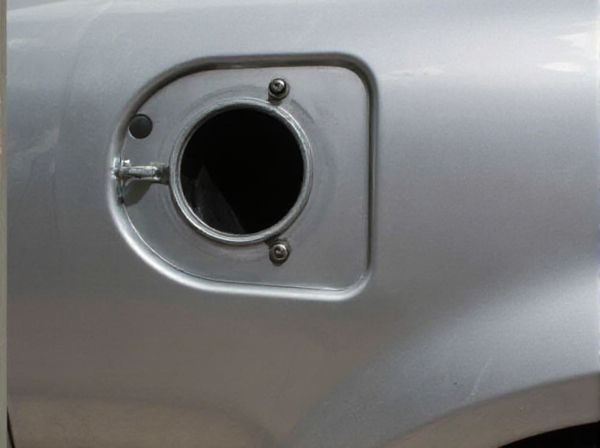
Photo illustration: Cylindrical Tank vs Rectangular Tank
Choosing between a cylindrical tank and a rectangular tank depends on space efficiency and application needs. Cylindrical tanks offer better structural integrity and pressure resistance, making them ideal for storing liquids under pressure. Your decision should consider the available space and the tank's use to optimize volume and durability.
Table of Comparison
| Feature | Cylindrical Fuel Tank | Rectangular Fuel Tank |
|---|---|---|
| Shape Efficiency | Optimal pressure distribution, reduces stress | Maximizes use of space, easier to fit in tight compartments |
| Capacity Utilization | Less efficient in tight spaces, potential wasted volume | Higher volume-to-space ratio, better fuel capacity |
| Manufacturing Complexity | Simple to manufacture and maintain | More complex fabrication, requires welds and seals |
| Durability | Strong structure, resists deformation | Prone to stress points at edges and corners |
| Installation Flexibility | Limited to cylindrical mounting spaces | Versatile installation shapes, adaptable to vehicle design |
| Cost | Generally lower manufacturing costs | Potentially higher due to complex design |
Introduction to Cylindrical and Rectangular Tanks
Cylindrical tanks offer uniform structural integrity due to their circular cross-section, making them ideal for storing liquids under pressure or varying temperatures. Rectangular tanks provide efficient use of space and easier integration into confined or modular layouts, often favored in industrial and commercial settings. Both tank types differ significantly in fabrication costs, maintenance, and application suitability, influencing their selection based on specific storage requirements.
Design and Structural Differences
Cylindrical tanks feature a circular cross-section, which provides uniform stress distribution and superior resistance to internal pressure, making them ideal for storing liquids and gases under pressure. Rectangular tanks, on the other hand, have flat surfaces and corners that require additional reinforcement to prevent deformation and to maintain structural integrity under load. The design complexity and material usage differ significantly, with cylindrical tanks typically offering better strength-to-material ratios, while rectangular tanks maximize space efficiency in confined areas.
Space Utilization and Footprint
Cylindrical tanks offer superior space utilization in terms of volume-to-surface area ratio, enabling efficient storage with less material waste compared to rectangular tanks. Rectangular tanks provide a more compact footprint for installation in confined spaces, optimizing floor area usage but often require more structural reinforcement due to stress concentration at corners. Choosing between cylindrical and rectangular tanks depends on balancing storage efficiency against available installation space and project-specific footprint constraints.
Fluid Dynamics and Mixing Efficiency
Cylindrical tanks promote superior fluid dynamics due to their curved walls, which enable uniform circulation and minimize dead zones, enhancing mixing efficiency. Rectangular tanks often suffer from corner stagnation, reducing flow turbulence and causing uneven mixing, which can hinder process consistency. Optimal tank selection depends on the mixing requirements, with cylindrical designs favored for applications demanding homogenous fluid agitation and improved shear rates.
Material and Construction Costs
Cylindrical tanks typically require less material for the same volume compared to rectangular tanks due to their geometric efficiency, resulting in lower construction costs. Rectangular tanks often incur higher costs because of the need for additional reinforcement to withstand internal pressure and prevent deformation. Material selection such as steel or reinforced concrete also influences overall expenses, with cylindrical shapes favoring uniform stress distribution and thus potentially reducing thickness and material usage.
Installation and Maintenance Requirements
Cylindrical tanks typically require less foundation work and simpler installation due to their uniform shape, which evenly distributes pressure and reduces stress points. Rectangular tanks demand more precise leveling and additional support structures to prevent deformation and ensure stability during installation. Maintenance for cylindrical tanks is generally easier as their curved surfaces facilitate better cleaning and minimize sediment buildup compared to the flat surfaces and corners of rectangular tanks.
Durability and Corrosion Resistance
Cylindrical tanks offer superior durability due to their uniform stress distribution, reducing weak points and enhancing structural integrity under pressure. Rectangular tanks, while easier to manufacture and space-efficient, often face higher risk of corrosion at corners and weld seams where stress concentrates. Materials like stainless steel or coatings such as epoxy significantly improve corrosion resistance in both tank types, but cylindrical tanks generally provide longer service life in harsh environments.
Applications and Industry Preferences
Cylindrical tanks are widely preferred in the chemical, oil, and gas industries due to their structural strength and efficient pressure distribution, making them ideal for storing liquids and gases under high pressure. Rectangular tanks are commonly used in water treatment, agriculture, and food processing sectors where space optimization and ease of installation in confined areas are crucial. Industry preferences lean towards cylindrical tanks for durability and maintenance efficiency, while rectangular tanks are favored for cost-effective storage and modular adaptability.
Environmental Impact and Sustainability
Cylindrical tanks generally offer better environmental sustainability due to their material efficiency and reduced surface area, which minimizes heat loss and energy consumption during temperature regulation. Rectangular tanks often require more construction materials and energy for insulation, leading to a higher carbon footprint over their lifecycle. Selecting cylindrical tanks can significantly lower overall environmental impact through optimized resource use and enhanced operational efficiency.
Choosing the Right Tank for Your Needs
Cylindrical tanks offer superior structural integrity and efficient pressure distribution, making them ideal for storing liquids under high stress or pressure. Rectangular tanks maximize space utilization within confined areas and simplify installation in modular systems or facilities with limited floor space. Selecting the right tank depends on application requirements, available space, and material compatibility to ensure optimal performance and cost-efficiency.
 caratoz.com
caratoz.com